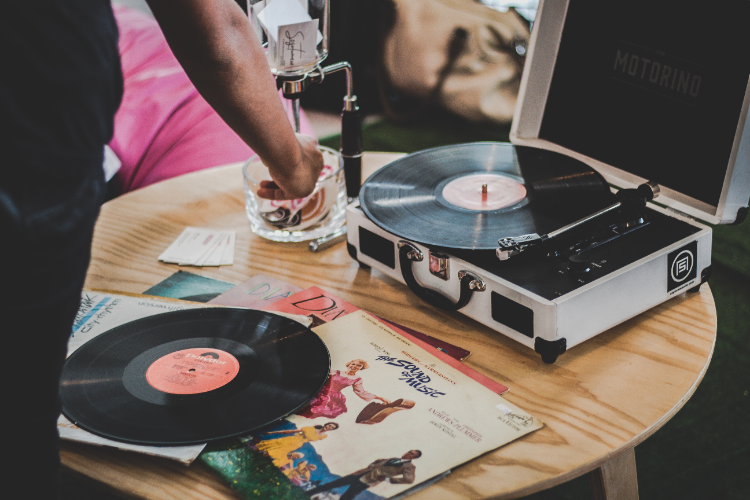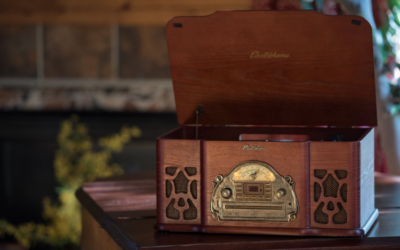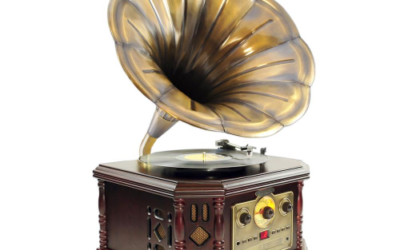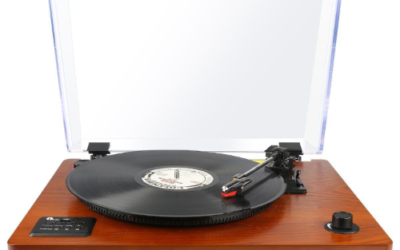You do care for style and thereby you love some nostalgia. Probably everything around you is carbon or polyester and clinically designed.
But you would like to stand out, right?
A vintage turntable does have that nostalgic look and will for sure bring character along with that.
But choosing the right Vintage Record Player can be tough!
So we’ve put together this resource A-ONE-STOP-SHOP ALL-INCLUSIVE GUIDE to help you find the right model that fits your style.
So, what is the bottom line?
You are at the right place to find your personal best Vintage Record Player!
Ultimate Guide – the Best Vintage Record Player 2020
5 important things for choosing your vintage record player
1. The picture of the device.
They look great, don’t they?
But there is more.
Watch better and bigger quality pics of the best looking turntables in 2017 here!
2. Brand and name/model – Click on them to view more details!
Or..go spoil yourself! A music lover like you deserves such a beautiful copy!
3. The Extra’s: Some of the best options the device has!
What ways are there to connect the device for storage or volume? Can you connect this one to a computer? All the answers are right there.
4. And off course – the Price
These are approximate prices on Amazon.com. These change frequently based on availability, special promotions and more.
But generally speaking:
$ = under $50
$$ = $50 to $100
$$$ = $100 to $200
$$$$ = $200 to $500
$$$$$ = $500+
5. The Rating – Our impression when using the turntable
You might be wondering: Is this the ULTIMATE GUIDE?
Truth is there are a lot of record players out there. To make your journey more easy, we reviewed some of the best models in different categories.
Record Player Reviews
We offer an inside look for multiple categories. Please find below the types and models we review.
In order to make our tested models easier to find, we provide an overview:
The 6 most important tested categories for the best vintage record player.
Attention please!
Our team truly adore the vintage turntables and put a lot of effort in this list, so we hope it provides you with what you need.
1. Best under 100 dollars
Here we show you the 5 BEST RECORD PLAYERS UNDER $100 that deliver some good music, look nice and are yet very affordable.
Is your budget limited to only $100? Don’t worry, there is still PLENTY to choose from!
2. Best Turntable Under 300 dollars
Among the numerous turntables that are available in the market, you just want that little extra. Whether it is good sound, a nice design or just a few more options.
If you are looking for the best turntable under 300 dollars, then read on!
3. Best Turntable Under 500 dollars
Considering the fact that you are searching for a turntable in this price range, it is clear that you want it to be darn good!
We get that.
So, we’ve compiled a list of turntables to guide you to the best turntable under 500 dollars! We examine if they are affordable, reliable, beautiful, powerful, and what great value they offer.
4. Best Crosley Record Player
For over a hundred years we’ve been blessed by the sweet melodies that Crosley record players make!
The Crosley players began to emerge on the market nearly a century ago!
And that speaks volumes about their quality, knowing that they’re still up and running.
A lot of things speak for their quality. First of all, the brand aged up with time, not against it, implementing the use of modern technology while still remaining true to the core.
If you are asking yourself at any time – “are the Crosley record players any good?”
Read the answers RIGHT HERE.
5. Best Portable Record Player
In modern times people usually listen to their music on their smartphones, computers, laptops, and other modern devices.
Portable Record Players offer you something that no phone or computer ever could – the amazing experience that could not be replaced or substituted by anything.
We are going to review the portable record players that are even more interesting due to their compactness.
Here is the list of the very best portable record players we’ve had the pleasure of coming across.
6. Best Record Player with Speakers
Today many players come with in-built speakers to free the users from hassles of connecting and carrying external speakers.
But not all the turntables with speakers deliver QUALITY sound.
Finding the best record player with speakers that deliver high-quality sound is not an easy job.
There are so many models available on the market.
So, here’s the deal:
We thought we can make your job easy by bringing you the details of the best record players with speakers. Enjoy!
And what about other categories?
You probably know by now that the record players in these reviews have a lot to offer. But possibly you haven’t made your choice yet.
Since we want to offer a comprehensive guide, we did not exaggerate about the effort of our team. What about a turntable with highly versatile settings? The Jensen All-In-One or the Teac All-In-One for example. Both record players that are equipped with various features.
Some turntable brands are a category on its own. Pro-Ject is one of the prominent leaders in the high-end turntable industry. A darn good reason to give this brand some special attention. Have a look at these different Pro-Ject Turntables for example.
More Vinyl Insights
If you read all the way down to here, you must be interested in some vintage vinyl insights.
We are right, aren’t we?
Do we have some great news for you!
Our team did not only spend hours and hours on testing the different turntables on our site.
We’re also deluded by the world of vinyl. The techniques, the origin and history are topics we can go on and on about for hours and hours.
We would like to welcome you in our crazy vinyl geek world with some in-depth information..read on!
Types of Classic Record Players
There are many ways to divide record players in different categories.
Preamp vs power amp, belt driven vs direct drive etc.
Those are more technical ways of discriminating between turntables.
Most people visiting this blog are choosing between a gramophone, the one with the big brass horn on the left, the Pyle-Home Vintage Phonograph Horn Turntable.
Or maybe a turntable model without a horn, in this example on the right the Electrohome Winston Vinyl Record Player.
Although these terms are not officially selecting for with/without horn, everybody understands the difference.
We are not going to get in debate which is better. They both clearly have specific benefits.
- Drawing attention. The big shiny brass horn immediately draws attention, this can be an advantage if you do like to show the gramophone. Some people however consider it too much of a presence in their room.
- Cleaning. With an ordinary record player being easy to clean, the horn does need some attention. In order to make is shine or at least keep it clean, you will have pledge some sweat.
- Space. Without a horn you can close the record player and put for instance some records on it. With the horn, there is no way that you are using that space.
- Sound. With the sound coming from the horn it does sound even more characteristic. All record players have that vinyl sound, but the horn can even add some vintage touch to that. Not all new gramophones however do really use the horn for musical output.
Reviews of THE 5: What is the Coolest Retro Record Player ?
PYLE-HOME PVNP4CD
The Pyle-Home is one of the most characteristic looking gramophones. With the handmade high quality wood veneer cabinet and prominent horn this is one of the top selling record players on Amazon.
And here’s the kicker:
The horn is not only there for charm and elegance!
It really does amplify the sound giving it a rich sound quality that will fill your room.
Additionally this classic vinyl record player is capable of playing a wide variety of music.
You can experience your vinyl records, CDs, cassettes, or tune into AM/FM radio.
On top of that, the 3.5mm aux-in port can also handle you music from Ipod or MP3 player.
The USB port gives you the opportunity to connect with your pc and record music straight to you hard disk or external drive.
In short this well designed and fully equipped classic vinyl player will bring both excellent style and high quality music to your room.
Wellington Nostalgia
One model that could for sure not be forgotten: The Electrohome Nostalgia.
With the massive wooden chest, this item has a classic look. But also the inside is attractive.
With this 4-in-1 model, you also get a CD function, an USB recording option and FM Radio.
Why are Old Fashioned Record Players so Popular again
Obviously you can buy a new high end Stereo system. But modern electronics probably do not represent your personality.
At the moment, vintage is hot. A beard, an old fashioned bike or retro design furniture, all are being popular at the moment.
And the same is true for musical instruments and in this case turntables.
Therefore mostly not the characteristic sound but more the looks of the record player that are the reason to place a turntable in the room.
And not only the old-school record player. Also the vinyl albums are being seen everywhere again.
With big events like Record-Store-Day the vinyl hype is only getting bigger!
One of our team members visited Chicago a while ago. He was surprised by the number of genuine Vinyl Stores he encountered. He decided he had to share this with fellow Vinyl lovers and wrote a where-to guide about Vinyl Stores in Chicago.
Belt Drive or Direct Drive
In every turntable, a motor is spinning the platter. This motor can be attached to the platter in two different ways. The motor can be placed next to the platter. An elastic belt is then used to connect the motor and the platter. This way of spinning the platter is called belt drive. An advantage of this system is the belt dampens the noise (vibration) of the motor.
An other way to drive the platter is not placing the motor besides the platter, but under it. Thereby the platter can be directly attached to the motor. In this process there is no dampening of the noise, but there is a more stable speed.
Old fashioned models almost all the time have the belt driven technology. DJ’s do prefer the direct driven models. When you are planning on creating sound effects as a DJ, the direct drive is your type. But for most people that buy the instrument to listen to music, belt driven is the way to go. See some models we tested for yourself here.
Manual or automatic tonearm placement
With a manual model, the user is required to lift the tonearm and place it on the platter with the album. For a automatic type, this is done by the device. Way more models are manual compared to automatic. The reason for being more common is not for technical issues or price. The main purpose of listening music from these instruments is the experience. Part of that experience in placing the needle carefully in the grooves.
Semi automatic models are becoming also more popular. Hereby the tonearm with stylus is placed above the plate, but not lowered. The lowering is done automatically by the push of a button. Thereby providing both the feeling of placing the stylus and preservation from the album.
Recording and USB functions
Nowadays most music is stored digital on hard disk or cloud. This ensures high quality and durability. With recording music from a USB turntable to a hard disk or laptop you can store your old school albums. With the recording being done really from the LP, the characteristic sound is also stored. With this recording therefore you have the sound of vinyl on a digital medium. This is making an excellent way to both store old music and giving an extra touch to your digital collection. Be sure to checkout if the model is suited for recording all LP sizes. With albums being produced on 33′, 45′ and 78′ size, there are a number of models that do not support all the formats. There will be no problem with 33 and 45, but 78 can be a problem for some recording players. Luckily several record players have this ability.
Best Vinyl Player in 2016
This one is not easy to answer, there are multiple interesting models added this year that could compete for best vinyl player 2016. At this moment we really get enthusiastic with the Crosley Dansette, mostly because of the combination of smooth sound with a vintage vinyl look. One other we must mention is the new version of the Electrohome Wellington, this vinyl player always delivers.
Is there a Best Record Player
This is one hard question to address. Because of the difference of need, the best turntable can differ from person to person. We review some models and thereby specify what type of user would benefit the most from this record player.
For the real audiophiles we dig a little deeper. What are the parts of a turntable that make it so special for their performance? You would be surprised, for sure. The turntable’s base, or plinth, for example.
The better the turntable plinth, the better the overall quality.
The History of Vinyl
Where it all began – Colombia Records
It was in 1948 when Colombia Records introduced the “long-playing-microgroove”, widely known as the LP. Colombia was originally founded in 1888, mainly distributing and selling Phonographs. By the end of the 19th century it started more tight cooperation’s with the company’s Edison and the North American Phonograph Company. By then, Colombia would focus itself on producing wax rollers, which were used in the Phonograph for recording and playing sound. The wax rollers, or Phonograph Cilinders, were in fact the first media for recording and producing sound, available for commercial purposes. Colombia and Edison kept on improving the quality of the Phonographs and the cylinders, while around the same time the German inventor Emile Berliner, invented the phonograph record.
The phonograph record is the predecessor of the Vinyl record, the main difference being the amount, size and quality of the grooves on the record, and off course the material itself. (More information in the section Techniques) The two media carriers competed and dominated the music recording industry in the first decades of the twentieth century, until at some point a big difference in production costs took form. Although the sound quality of a cylinder in a phonograph was as good as a record on a disc record gramophone, the latter was way more suitable for mass production and thereby commercially more profitable. So from around the early 1920’s until the late 1940’, the phonograph record was the mainstream sound equipment in the United States, followed by the Vinyl record in 1948.
Techniques – How does it work?
As said before, the predecessor of the Vinyl record was the Phonograph record. So why this invention?
At first, the phonograph disc was made out of an abrasive shellac on a label, which made it very delicate and easy to break. In fact, this was a common problem back then. If possible, ask an old and aged person if he ever tried to play an broken record. Strange question right? Well, in fact, the label still kept the abrasive together, that made it possible. Second, the size of the shellac discs became larger and larger because it could only contain eighty to a hundred groove walls per inch before the risk of groove wall collapse would become too high. This off course limited the amount of sound and playing time on a record to less than five minutes per side. So in the middle of the 1940’s major music labels started experimenting with laminated records. The material had to be more firm, in order to add playtime and to be more lasting against use. Yet the sound quality had to be sufficient, so no rough materials. Vinyl turned out to be the way. An aluminium disc covered with pre-heated Vinyl would be compressed into a hydraulic record press with thin nickel stampers that were negative impressions of a master disc. This compressing method forced the hot Vinyl to fill the grooves in the nickel stampers, and take the form of the final product. This new product was a fine-grooved (hence the “micro-groove”) disc, available in 12 or 10 inches. It would be played by a special stylus with a smaller tip. This resulted in playtime per side of more than 20 minutes. An almost seventy percent increase per side, not bad! Another advantage of this production method and use of materials was a more steady product, although it still had to be handled with care, because of the sensitive surface of the Vinyl.
Here’s a video that show’s you how it works..
Global Influence
So, remember that before the invention and distribution of the Phonograph, the only way to listen to music was actually to see and hear a live performance. Recorded sound simply did not exist until the last quarter of the ninetieth century. Well, to be more precise, at least not for the common man. In the early years of these “remarkable” machines, one was divided. Sure they were very suitable for people who were not able to attend performances or make music by their selves, but one feared that it would undermine the creation of original pieces. In fact, living in the begin of the twenty-first century and looking back for say a hundred years, one cannot deny that for the last three of four decades many and many successful artists became successful by using samples from songs of the old days.
The possibility of and access to recorded music however, had some very positive influences on global culture itself. It resulted in much bigger exposure to a wide variety for all types people. A good example of this was the rise in popularity of black artists in the 20th century. This population group is known for their musical talent, as much as for their suffering during their years of oppression in recent history. Local musicians who made recordings could share their music worldwide, thanks to the easiness of stamping out large numbers of copies. This helped to begin to bridge the racial cross-roads of whites and blacks in the United States. Think of several famous Jazz Musicians, and off course the unprecedented success of the Motown years.
Especially the invention of the LP by Colombia marked a new era in home recording and the fame of numerous of artist. One of the reasons was the high fidelity sound of an LP on a record player. Now it was like listening to a studio-recorded performance! Next to that, the LP was never intended for singles. In fact, because of the used techniques, a lot more music fitted both sides. So when record companies discovered that a particular song from an artist became popular on the radio, they would not only produce that one song. They would produce a whole album, stimulating (or forcing, for that matter) the consumer to buy the whole album, which of course contained the one hit-single, but many other songs as well.




